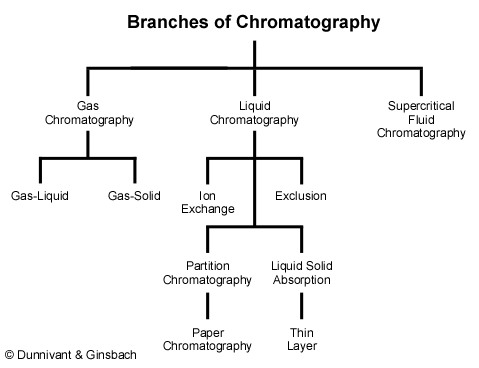1.1 Introduction
Analytical chemists have few tools as powerful as chromatography to measure distinct analytes in complex samples. The power of chromatography comes from its ability to separate a mixture of compounds, or “analytes”, and determine their respective identity (chemical structure) and concentration. Chromatography can be divided into three basic types that include gas, liquid, and supercritical fluid chromatography. Liquid chromatography can further be divided into ion exchange, separations based on size, and even extended to gel-based electrophoretic techniques. This book will provide a basic introduction to different types of liquid and gas chromatography. The relationship between each type of chromatography is illustrated in Figure 1.1.

Figure 1.1. Categories of Chromatography and Their Relationship to Each Other.
In general, each type of chromatography is comprised of two distinct steps: chromatography (or separation of individual compounds in distinct elution bands) and identification (detection of each elution band). Gas chromatography is the process of taking a sample and injecting it into the instrument, turning the solvent and analytes into gaseous form, and separating the mixture of compounds into individual peaks (and preferably individual compounds). Liquid chromatography completes the same process except the separations occur in a liquid phase. Individual band or peaks exit the column and identification occurs by a relatively universal detector. One particularly common detector for both gas and liquid chromatography is mass spectrometry (MS) which transforms each analyte from a chemically neutral species into a positive cation, usually breaking various bonds in the process. Detecting the mass of the individual pieces (referred to as fragments) allows for conclusive identification of the chemical structure of the analyte. Principles of gas chromatography (GC) will be covered in Chapter 2, liquid chromatography (LC) in Chapter 3, capillary electrophoresis (CE) in Chapter 4 and mass spectrometry (MS) in Chapter 5.
In mass spectrometry, the combination of compound separation and ion fragment identification (the subject of Chapter 6) yields an extremely powerful analysis that is said to be confirmatory. Confirmatory analysis means the analyst is absolutely sure of the identity of the analyte. In contrast, many other individual techniques and detectors are only suggestive, meaning the analyst thinks they know the identity of an analyte. This is especially true with most universal GC and LC detectors since these detectors respond similarly to many compounds. The only identifying factor in these chromatographic systems is their elution time from the column. In order to obtain confirmatory analysis the sample would need to analyzed by at least two or more techniques (for example, different separation columns) that yield the same results. Mass spectrometry and nuclear magnetic resonance (NMR) are two confirmatory techniques in chemistry.
At this point, it is important to understand the different applications GC-MS and LC-MS offer for two different types of chemists, analytical and synthetic organic chemists. Organic chemists attempt to create a desired chemical structure by transforming functional groups and intentionally breaking or creating bonds; in their resulting identification procedures they already have a relatively good idea of the chemical structure. To characterize the resulting product the chemist will use Infrared Spectroscopy (IR) to observe functional groups, Mass Spectrometry (MS) to obtain the compound’s molecular weight, and Nuclear Magnetic Resonance (NMR) spectroscopy to determine the molecular structure. Information from all three techniques is used to conclusively identify the synthesized product.
Analytical chemists are forced to approach identification in a different way, because they have no a priori knowledge of the chemical structure and because the analyte is usually present at low concentrations where IR and NMR are inaccurate. Often, analysis is performed to look for a desired compound by comparing the sample analysis to that of a known (reference) compound. The reference is used to identify the unknown compound by matching retention time (in chromatography) and ion fragmentation pattern (in mass spectrometry). With today’s computer mass spectral libraries that contain ion fractionation patterns for numerous chemicals, the analyst has the option of not using a reference standard. This is especially valuable if a reference compound is not available or is expensive. In some cases, especially with low analyte concentration, this approach may only result in a tentative identification.
This book will focus on GC-, CE-MS and LC-MS applications from an analytical chemistry perspective even though many synthetic chemists will also find much of this information useful for their applications.
| Frank's Homepage |
©Dunnivant & Ginsbach, 2008